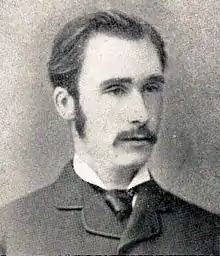Nathaniel Colgan
Nathaniel Colgan (1851 Dublin – 1919 Dublin) was a self-taught Irish naturalist primarily known for his botanical work.
Nathaniel Colgan | |
|---|---|
 | |
| Born | 28 May 1851 |
| Died | 2 October 1919 (aged 68) |
| Known for | identifying the botanical species meant by the term 'shamrock' |
| Scientific career | |
| Fields | Botany |
Life
Very little is known about Colgan's early life, but it is believed his parents may have been Nathaniel Watson Colgan and Letitia Phair.[1] If correct his father, a pawnbroker, died on 23 January 1863 at Bishop-street, Dublin City and his mother died 26 April 1865, at Rehoboth House, South Circular Road, Dolphin's Barn just prior to Nathaniel's fourteenth birthday. After leaving the Incorporated School, Angier Street, Dublin City, Colgan began work as a clerk and from the age of twenty worked in the Dublin Metropolitan Police Court remaining there until his retirement in 1916.[1]
He began visiting Europe every summer from 1875, and these trips inspired many of the contributions to a magazine of literary manuscripts, Varieties.[2] He was a regular contributor to the magazine from 1873 and edited it for a number of years.[2] Colgan also contributed to Irish Monthly, Tinsley's Magazine and Hibernia.[1] A shy and private person he did develop friendships through his membership of field clubs and an interest in nature, including Charles F. D'Arcy, later Anglican Archbishop of Dublin and Robert Lloyd Praeger.
Colgan never married and died in Dublin on 2 October 1919.[1] After moving from Rathmines about 1900 he lived with his unmarried sisters, Annie and Letitia and a brother, John Joseph, at 15 Breffni Terrace, in Sandycove. A married brother was the Rev. William Henry Colgan, Rector of Ballinlough, County Roscommon.
Botanical and zoological work
Colgan became a keen amateur botanist following his discovery in 1884 of the rare plant saw-wort in Wicklow[1] and was encouraged by Alexander Goodman More to study botany further.[3] He began working on his The Flora of County Dublin in the 1890s but publication was delayed as he and Reginald W. Scully undertook to edit Contributions towards a Cybele Hibernica : being outlines of the geographic distribution of plants in Ireland, founded on the papers of the late Alexander Goodman More following the death of his friend in 1895.
Colgan is noted for his work in identifying the botanical species meant by the term 'shamrock' in the 1890s.[4] He did this by requesting people from around Ireland send him specimens of what they believed to be an Irish shamrock.[5] After tending these specimens until they flowered, Colgan identified five most common plant species. The most common was yellow clover, followed by white clover, red clover, black medic and finally wood sorrel.[6] Dr Charles Nelson repeated the experiment in 1988, marking a hundred years since Colgan's original survey, and found that yellow clover was still the most commonly chosen.[5] Yellow clover is also the species that is cultivated for sale in Ireland on Saint Patrick's Day[6] and has been nominated by Department of Agriculture as the "official" shamrock of Ireland.[5]
Moving to Sandycove in 1900, Colgan developed an interest in marine invertebrates,[2] particularly Mollusca and tunicates.[1] Colgan recorded the marine Mollusca collected during the Clare Island Survey and his large mollusc collections from County Dublin and Clare Island were subsequently donated to the Natural History Museum Dublin.[7]
Colgan's interest in vernacular and Irish language names for various plants and animals was reflected in his other work into jellyfish, starfish and periwinkles[8] and his contribution to the Clare Island Survey.[9]
Works
Partial list:
- 'The Shamrock: an attempt to fix its species' The Irish Naturalist: a monthly journal of general Irish natural history, Vol. 1, No. 5, 95–97, (August 1892)
- 'The Shamrock: a further attempt to fix its species' The Irish Naturalist: a monthly journal of general Irish natural history, Vol. 2, No. 8, 207–211, (August 1893)
- Flora of the County Dublin. Hodges, Figgis & Co., Dublin (1904)
- 1907 Contributions to a natural history of Lambay: marine Mollusca. Irish Naturalist 16: 33-40 (1907)
- Clare Island Survey: Gaelic plant and animal names, and associated folk-lore. Proceedings of the Royal Irish Academy 31B: 1-30 (1911)
- Clare Island Survey: Marine Mollusca. Proceedings of the Royal Irish Academy 31B: 1-36 (1911)
- The opisthobranch fauna of the shores and shallow waters of County Dublin. Irish Naturalist 23: 161-204 (1914)
- The marine Mollusca of the shores and shallow waters of County Dublin. Proceedings of the Royal Irish Academy 39B: 391-42 (1930)
References
- Bohan, Rob; Lunney, Linde. "Colgan, Nathaniel". Dictionary of Irish Biography. Cambridge University Press.
{{cite web}}: Missing or empty|url=(help) - Unknown. "Colgan, Nathaniel (1851-1919)". Global Plants. Jstor. Retrieved 17 February 2015.
- Praeger, R. Lloyd. "Nathaniel Colgan". Some Irish Naturalists: A Biographical Note-book. National Botanic Gardens of Ireland. Archived from the original on 15 November 2017. Retrieved 17 February 2015.
- Pavord, Anna (2010). The Naming of Names: The Search for Order in the World of Plants. London: A&C Black. ISBN 9781408820766.
- Mulvihill, Mary (2012). "Why is the shamrock a sham?". Ingenious Ireland. Retrieved 17 February 2015.
- Mulvihill, Mary (2003). Ingenious Ireland: A County-by-County Exploration of the Mysteries and Marvels of the Ingenious Irish. Dublin: Simon and Schuster. p. 352. ISBN 9780684020945.
- Nunn, J.D.; Holmes, J.M.C. (2008). "History of the Irish & British Marine Molluscan Collections". A Catalogue of the Irish and British Marine Mollusca in the collections of the National Museum of Ireland - Natural History 1835-2008. National Museums Northern Ireland. Retrieved 17 February 2015.
- Lysaght, Sean (1998). "Contrasting Natures: The Issue of Names". In Wilson Foster, John; Chesney, Helena C. G. (eds.). Nature in Ireland: A Scientific and Cultural History. McGill-Queen's Press. ISBN 9780773518179.
- Colgan, Nathaniel (1911). Part 4. Gaelic Plant and Animal Names, and Associated Folk-Lore. Dublin: Royal Irish Academy. Retrieved 17 February 2015.